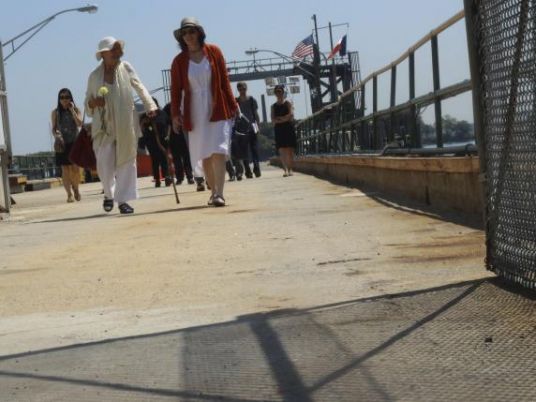
It takes a mere 10 minutes by boat to navigate to New York City's Hart Island, one of the United States' largest paupers' cemetery.
But it took Rosalee Grable more than a year to reach the gravesite where her mother was buried on the uninhabited strip of land off the city's Bronx borough.
Grable, 64, was one of a few dozen mourners who for the first time walked across the barren island on Sunday. The trip marked the end of the long isolation of the site, where about 1 million people are buried.
"I'm so grateful to be able to go there and stand at her grave," she said, holding a bouquet of flowers she planned to leave on the island.
For years, city rules confined mourners to a small memorial gazebo, furnished with a few benches and tucked away on an island's corner.
The city's Department of Correction, which runs the island, had long argued that it needed to limit access to the cemetery due to security concerns and a lack of amenities.
But following the settlement of a class-action lawsuit earlier this month, authorities have begun ferrying relatives and their guests, at least once a month, to the island for visits beyond the restricted area.
The settlement, the result of a lawsuit brought against New York City by the New York Civil Liberties Union, is awaiting a federal judge's final approval.
Purchased in 1869 by city authorities, Hart Island has at various times been a prison, a hospital, an insane asylum, and finally a 131-acre (53-hectare) potter's field where the unlucky many have been laid to rest in unmarked, graves which orange-clad inmates, dig to this day.
As many as one million people have been interred in the graveyard, according to local authorities. Many are in mass graves. Their remains were either unclaimed or their families could not afford a burial.
Grable's mother, Gladys Van Aelst, who died aged 85, ended up on the city-administered potter's field because her family lacked the resources to pay for a private burial, she said.
"She had a $2,500 burial fund stashed away in her savings, but she sent that to my sister to buy a car with, about three months before she got sick," Grable said.
The island's successive incarnations have carved a landscape both strikingly beautiful and desolate. Buildings ripped open dot an expanse of otherwise seemingly untouched vegetation. A 30-foot (9 m) tall, monolithic monument to the unclaimed dead, engraved with a cross and the word 'Peace', towers over the graveyard.
"It's like this big open-air cathedral," said Melinda Hunt, a Canada-born artist who has championed the rights of the deceased and grieving of Hart Island, who accompanied the mourners on Sunday.




